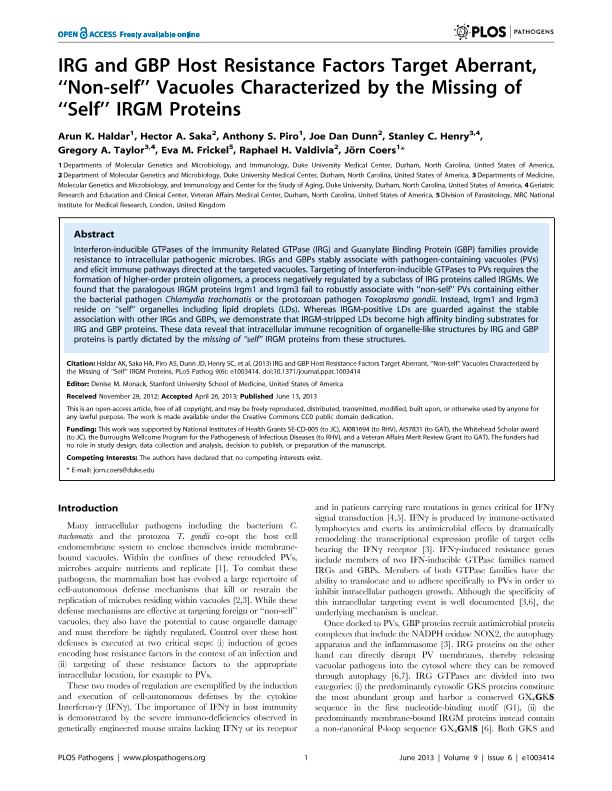Mostrar el registro sencillo del ítem
dc.contributor.author
Haldar, Arun K.
dc.contributor.author
Saka, Hector Alex

dc.contributor.author
Piro, Anthony S.
dc.contributor.author
Dunn, Joe Dan
dc.contributor.author
Henry, Stanley C.
dc.contributor.author
Taylor, Gregory A.
dc.contributor.author
Frickel, Eva M.
dc.contributor.author
Valdivia, Raphael H.
dc.contributor.author
Coers, Jörn
dc.date.available
2016-12-22T21:54:58Z
dc.date.issued
2013-06
dc.identifier.citation
Haldar, Arun K.; Saka, Hector Alex; Piro, Anthony S.; Dunn, Joe Dan; Henry, Stanley C.; et al.; IRG and GBP host resistance factors target aberrant, ‘‘Non-self’’ vacuoles characterized by the missing of ‘‘Self’’ IRGM proteins; Public Library Of Science; Plos Pathogens; 9; 6; 6-2013; 1-5
dc.identifier.issn
1553-7366
dc.identifier.uri
http://hdl.handle.net/11336/10015
dc.description.abstract
Interferon-inducible GTPases of the Immunity Related GTPase (IRG) and Guanylate Binding Protein (GBP) families provide resistance to intracellular pathogenic microbes. IRGs and GBPs stably associate with pathogen-containing vacuoles (PVs) and elicit immune pathways directed at the targeted vacuoles. Targeting of Interferon-inducible GTPases to PVs requires the formation of higher-order protein oligomers, a process negatively regulated by a subclass of IRG proteins called IRGMs. We found that the paralogous IRGM proteins Irgm1 and Irgm3 fail to robustly associate with ‘‘non-self’’ PVs containing either the bacterial pathogen Chlamydia trachomatis or the protozoan pathogen Toxoplasma gondii. Instead, Irgm1 and Irgm3 reside on ‘‘self’’ organelles including lipid droplets (LDs). Whereas IRGM-positive LDs are guarded against the stable association with other IRGs and GBPs, we demonstrate that IRGM-stripped LDs become high affinity binding substrates for IRG and GBP proteins. These data reveal that intracellular immune recognition of organelle-like structures by IRG and GBP proteins is partly dictated by the missing of ‘‘self’’ IRGM proteins from these structures.
dc.format
application/pdf
dc.language.iso
eng
dc.publisher
Public Library Of Science

dc.rights
info:eu-repo/semantics/openAccess
dc.rights.uri
https://creativecommons.org/licenses/by-nc-sa/2.5/ar/
dc.subject
Irg
dc.subject
Gbp
dc.subject
Droplets
dc.subject
Chlamydia
dc.subject.classification
Biología Celular, Microbiología

dc.subject.classification
Ciencias Biológicas

dc.subject.classification
CIENCIAS NATURALES Y EXACTAS

dc.title
IRG and GBP host resistance factors target aberrant, ‘‘Non-self’’ vacuoles characterized by the missing of ‘‘Self’’ IRGM proteins
dc.type
info:eu-repo/semantics/article
dc.type
info:ar-repo/semantics/artículo
dc.type
info:eu-repo/semantics/publishedVersion
dc.date.updated
2016-12-19T18:05:16Z
dc.journal.volume
9
dc.journal.number
6
dc.journal.pagination
1-5
dc.journal.pais
Estados Unidos

dc.journal.ciudad
San Francisco
dc.description.fil
Fil: Haldar, Arun K.. University Of Duke; Estados Unidos
dc.description.fil
Fil: Saka, Hector Alex. University Of Duke; Estados Unidos. Consejo Nacional de Investigaciones Científicas y Técnicas. Centro Científico Tecnológico Córdoba. Centro de Investigaciones en Bioquímica Clínica e Inmunología; Argentina
dc.description.fil
Fil: Piro, Anthony S.. University Of Duke; Estados Unidos
dc.description.fil
Fil: Dunn, Joe Dan. University Of Duke; Estados Unidos
dc.description.fil
Fil: Henry, Stanley C.. University Of Duke; Estados Unidos. Veteran Affairs Medical Center; Estados Unidos
dc.description.fil
Fil: Taylor, Gregory A.. University Of Duke; Estados Unidos. Veteran Affairs Medical Center; Estados Unidos
dc.description.fil
Fil: Frickel, Eva M.. National Institute for Medical Research; Reino Unido
dc.description.fil
Fil: Valdivia, Raphael H.. University Of Duke; Estados Unidos
dc.description.fil
Fil: Coers, Jörn. University Of Duke; Estados Unidos
dc.journal.title
Plos Pathogens

dc.relation.alternativeid
info:eu-repo/semantics/altIdentifier/url/http://www.plospathogens.org/article/info%3Adoi%2F10.1371%2Fjournal.ppat.1003414
dc.relation.alternativeid
info:eu-repo/semantics/altIdentifier/doi/http://dx.doi.org/10.1371/journal.ppat.1003414
dc.relation.alternativeid
info:eu-repo/semantics/altIdentifier/url/https://www.ncbi.nlm.nih.gov/pmc/articles/PMC3681737/
Archivos asociados
